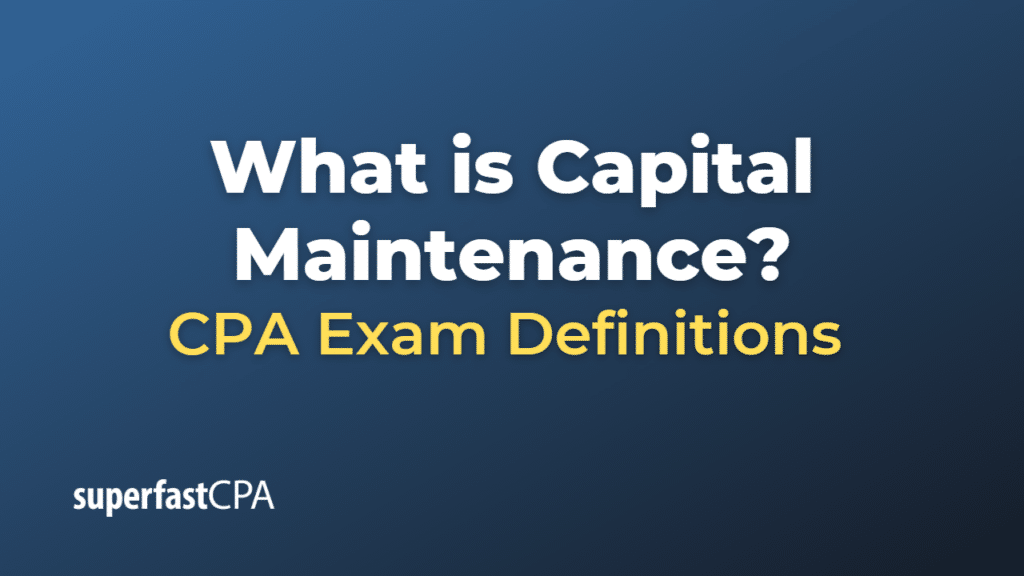Capital Maintenance
Capital maintenance is an accounting concept that focuses on preserving the productive capacity or economic value of a business over time. It helps ensure that a company maintains sufficient resources to continue its operations and generate future income, by reinvesting profits or raising additional capital as needed. Capital maintenance can be approached in two ways: financial capital maintenance and physical capital maintenance.
- Financial capital maintenance: This approach measures capital maintenance in monetary terms, considering a company to have maintained its capital if its net assets (assets minus liabilities) at the end of an accounting period are equal to or greater than the net assets at the beginning of the period, after accounting for any distributions to owners (e.g., dividends). Under financial capital maintenance, a company generates a profit only if it increases its net assets over the accounting period, after considering the impact of any distributions to owners.
- Physical capital maintenance: This approach measures capital maintenance in terms of the productive capacity or physical resources of a company. A company is considered to have maintained its capital if it retains or replaces the same physical quantity and quality of productive assets at the end of an accounting period as it had at the beginning, regardless of any changes in the monetary value of those assets. Under physical capital maintenance, a company generates a profit only if it increases its productive capacity over the accounting period.
Capital maintenance is important for the sustainability and long-term success of a business. By focusing on maintaining its capital, a company can ensure that it has the necessary resources to continue operating, adapt to changing market conditions, and pursue growth opportunities. Capital maintenance can also help prevent the erosion of a company’s asset base due to excessive distributions to owners or inadequate reinvestment in its operations.
Example of Capital Maintenance
Let’s consider a fictional example of a company called “EcoFurniture Inc.” to illustrate the concept of capital maintenance.
EcoFurniture is a manufacturer of eco-friendly furniture products. The company has a productive capacity that requires it to maintain a certain level of machinery, equipment, and other productive assets to continue its operations and meet customer demand.
Suppose EcoFurniture starts the accounting period with net assets of $1,000,000. During the year, the company generates $200,000 in net income (revenue minus expenses), and it also pays out $50,000 in dividends to its shareholders.
Let’s analyze EcoFurniture’s capital maintenance from both financial and physical perspectives:
- Financial capital maintenance: At the end of the accounting period, EcoFurniture’s net assets should be equal to or greater than $1,000,000 to maintain its capital. After generating $200,000 in net income and paying $50,000 in dividends, the net assets would be $1,150,000 ($1,000,000 + $200,000 – $50,000). Since the net assets at the end of the period are greater than the net assets at the beginning, EcoFurniture has maintained its capital from a financial perspective.
- Physical capital maintenance: Suppose EcoFurniture’s machinery, equipment, and other productive assets have a useful life of 10 years and are subject to wear and tear. To maintain its productive capacity, the company needs to reinvest a portion of its earnings in replacing or upgrading these assets as they age or become obsolete. If EcoFurniture reinvests $100,000 during the year to maintain or improve its physical assets, it ensures that its productive capacity is preserved, and it has maintained its capital from a physical perspective.
In this example, EcoFurniture has maintained its capital both financially and physically by ensuring that its net assets have increased and its productive capacity is preserved. By focusing on capital maintenance, the company can continue operating, meeting customer demand, and pursuing growth opportunities while avoiding the erosion of its asset base due to excessive distributions to shareholders or inadequate reinvestment.













